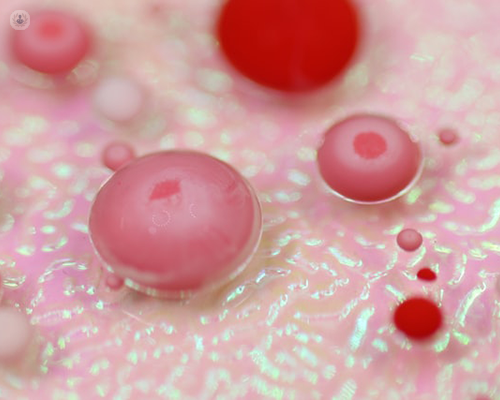Low-grade lymphoma
Dr Salim Shafeek - Haematology
Created on: 12-10-2018
Updated on: 04-03-2023
Edited by: Jay Staniland
What is low-grade lymphoma?
Lymphoma is the most common type of blood cancer. It occurs when the white blood cells (lymphocytes) change and grow excessively out of control. These white blood cells are found in the lymph nodes, spleen, thymus, bone marrow and other parts of the body.
There are two main types of lymphoma; non-Hodgkin and Hodgkin lymphoma, which both involve different types of lymphocyte cells, proteins present on the surface of their cells and the genetic mutation that occurs in the cells. Two grades of non-Hodgkin exist, high-grade lymphoma (grows quickly) and low-grade lymphoma (grows slowly).

What causes low-grade lymphoma?
Low-grade non-Hodgkin lymphoma develops when some types of white blood cells grow in an uncontrolled way. Although the cause behind this is usually unknown, the disease more commonly affects older people and is very rarely found in children.
What are the symptoms of low-grade lymphoma?
As low-grade lymphoma is slow growing and slow to spread, the symptoms may not be as noticeable. Possible symptoms are also common to all non-Hodgkin’s lymphomas. One of the commonest symptoms is swollen lymph nodes that cause a lump, which is also known as swollen glands. Other symptoms may include:
- fever
- weight loss
- loss of appetite
- severe night sweats
- chest or abdominal pain
- fatigue
- itchy skin
- skin rash
How is it diagnosed?
Low-grade lymphoma is found during a routine medical examination as it is not common to have many obvious symptoms. Thorough diagnostic testing is required to determine the type and stage of the disease.
The only way to confirm a diagnosis is through a lymph node biopsy. This is a minor surgical procedure that takes a sample of the affected lymph node, which is examined under a microscope in a laboratory.
Following a lymph node biopsy, the patient will have more tests such as a blood test for a full blood count. There will be a liver function test to check if the liver is working normally. The urea and electrolytes are also tested to check whether there has been any damage to the kidneys.
What is the staging of low-grade non-Hodgkin lymphoma?
The stage of the lymphoma describes how far that it has spread and will help to determine which treatment option is right for the patient. Most people have advanced stage low grade non-Hodgkin lymphoma when they are diagnosed.
Early stage – stage one and rarely stage two – can be successfully treated and the patient stays in remission (cancer free) for a long time. The advanced stages – three and four - are difficult to cure. As these stages are chronic and need regular treatment the lymphoma has periods of being in remission and relapsing, meaning it keeps coming back and needs more treatment.
Is low-grade non-Hodgkin lymphoma curable?
Early stage (first or second) low-grade non-Hodgkin lymphoma is usually treatable and in some cases is curable. This means the disease can normally be controlled for a long time, even if it doesn’t fully disappear.
Unfortunately, stage three and four low-grade non-Hodgkin lymphoma is more advanced and treatment aims to control rather than cure the disease. Nonetheless, treatment can often control the disease for several years before it recurs. When the lymphoma recurs, more treatment is required and often this pattern repeats over time. The periods of remission between periods where treatment is required generally become shorter over time.

How is low-grade non-Hodgkin lymphoma treated?
There are different phases of treatment for low-grade lymphoma. These are:
- watch and wait – the doctor may decide not to give treatment if there are no symptoms during diagnosis but they will keep a close eye on the patient
- first line treatment – for those with very enlarged lymph nodes, it may be recommended to have a combination of chemotherapy and immunotherapy called a monoclonal antibody
- maintenance treatment – once in remission, there may be maintenance treatment for some types of low-grade lymphoma, which may help to delay the lymphoma from returning
- second line treatment – there are lots of different options in case the low-grade lymphoma comes back after a period of time and it may be recommended to have a combination of chemotherapy with other drugs.
Can low-grade non-Hodgkin lymphoma recur?
Depending on when the lymphoma is first diagnosed and treated, it is possible that it may recur over time. If diagnosed in the early stages, low-grade non-Hodgkin lymphoma can be treated very effectively and even cured in some cases. It is possible that low-grade non-Hodgkin lymphoma can recur after some years and further treatment may be required.
What type of doctor treats low-grade non-Hodgkin lymphoma?
Specialist haematologists and oncologists treat low-grade non-Hodgkin lymphoma.




